PBN (Private Blog Network) is a group of websites created by a single owner specifically for placing links to promoted resources. This is one of the most powerful yet controversial tools for building link weight.
If you want to take your project promotion to the next level using a PBN but are held back by potential risks and complexities, our article will help you navigate these challenges. We'll explain how a PBN works, how to build one from scratch, and how to safely integrate this strategy into your overall promotion plan.
What is a PBN and How It Works
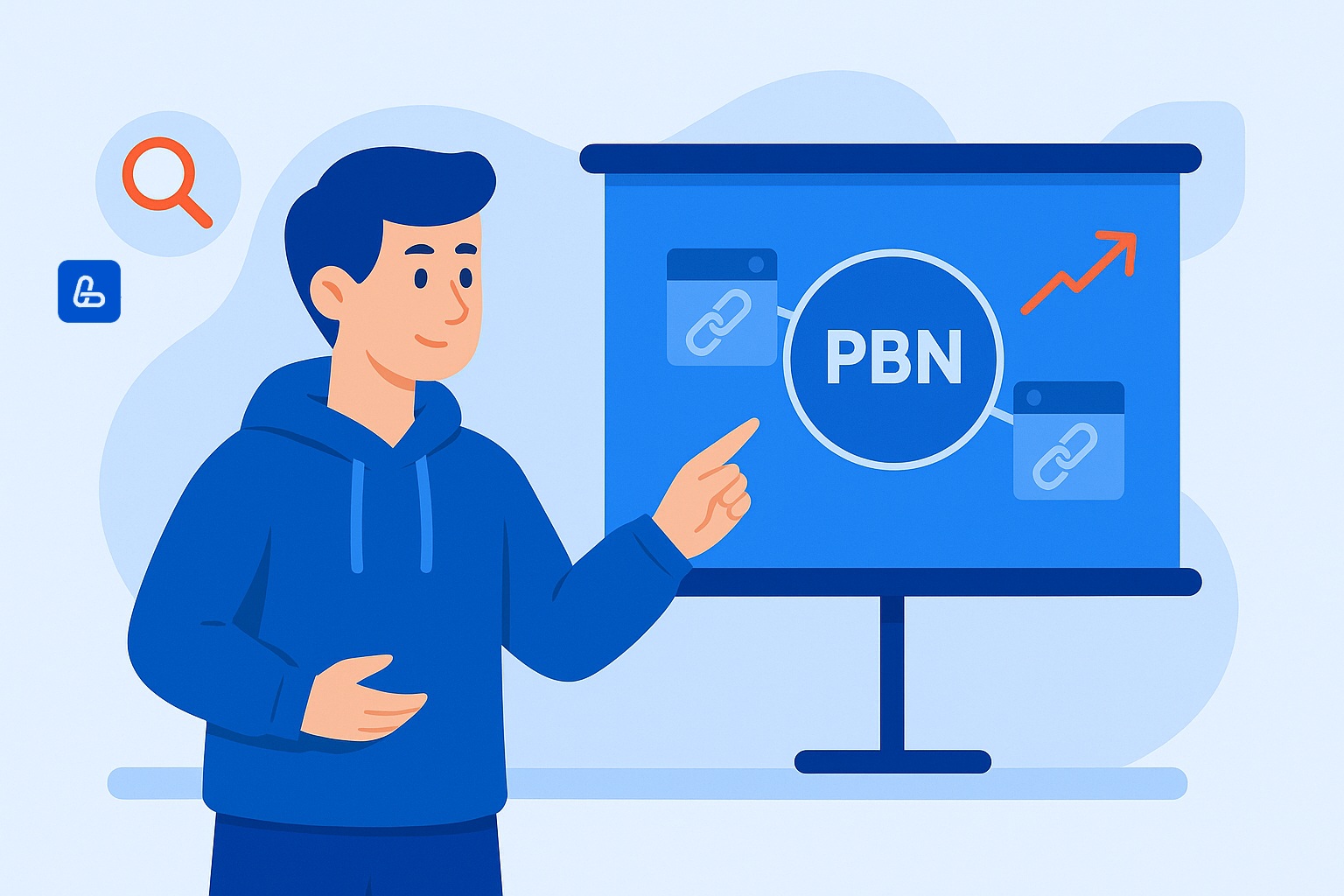
A private blog network consists of websites managed by a single owner. Each site in this network places links to promoted resources (acceptors), transferring its authority to them and thereby improving their search positions.
The core of a PBN's operation is the principle of link weight transfer. Search engines analyze the quantity and quality of inbound links to a site, using this data for ranking. The higher the authority of the donor site (from the PBN network), the more weight it transfers to your page.
The effectiveness of the entire network directly depends on the quality of the domains in its composition. Aged domains with a clean history and strong link profiles transfer significantly more weight. In contrast, new domains or those previously under filters can be useless or even harm your site.
Types of PBN Links
What is a PBN link? It's a regular hyperlink placed on a site from your controlled network. You independently choose the anchor text, the link's surroundings, and the publication timing. They come in different types – let's examine them in more detail.
Contextual Links
Contextual links are organically integrated into the main text of an article. They are considered the most valuable from an SEO perspective, as search engines perceive them as natural recommendations.
Such links are placed within valuable content, which increases their relevance and trustworthiness in the eyes of algorithms. For maximum effectiveness, it's recommended to surround them with high-quality text matching the theme of the promoted site.
Non-Contextual Links
- Sidebar links – permanent links in the site's side column
- Footer links – placed in the footer of all site pages
- Widget links – can be located in various functional blocks
Such links transfer less weight than contextual ones but help create a diverse link profile. Their main drawback is that they can become unnatural if overused.
Anchor Links
- Exact-match anchors – contain pure keywords ("buy iPhone")
- Diluted anchors – keywords with additional words ("you can buy a new iPhone here")
- Anchorless links – site URL or words like "here," "learn more"
- Branded anchors – contain the company or brand name
The optimal strategy assumes a predominance of anchorless and branded links (about 80-90%), while exact-match anchors should not exceed 5-10% of the total links.
Links Depending on Placement on the Site
- Homepage links - placed on the main page (the most powerful type)
- Links from static pages - located on permanent pages like "About Us," "Contacts"
- Links from blog posts - placed in site articles and news
Each type of link plays its role in forming a natural link profile. Combining different kinds helps mimic organic link mass growth and reduces the risk of sanctions from search engines.
Building PBN Links
PBN link building is the process of creating a network of sites to place links to your target resources on them.
The primary difference between SEO links from a PBN and natural ones is the ability to fully control all parameters. You can select optimal anchors, regulate the frequency and appearance of links, their position, and their surroundings.
The basic principles of building such a network involve creating sites that look natural and independent from each other. This is achieved through using various domain zones, hosting providers, CMS, designs, and content types.
Creating a PBN involves registering or purchasing domains, hosting them on various servers, setting up websites, writing unique content, and strategically placing links. Each step requires a thoughtful approach and attention to security.

PBN links work on the principle of transferring authority from one site to another. The quality of this transfer depends on several factors: donor authority, content relevance, link text, its page placement, and surrounding context.
A link will be more effective if the donor site is related to your main theme. For example, a link from a sports nutrition portal to an online sports goods store will be more useful than one from a cooking blog.
How PBN Complements Other SEO Methods
PBN successfully integrates into a comprehensive promotion:
- SEO audit and site optimization. PBN contributes to growing external link mass, working in tandem with proper internal optimization.
- Content marketing. High-quality content on main platforms can be boosted with PBN links, increasing its weight in search engines' eyes.
- Link campaigns. Unlike guest posts or crowd marketing, PBN allows full control over the context and parameters of each link, significantly increasing their predictable effectiveness.
- Technical SEO. Properly implemented PBN does not directly affect the main site's loading speed or structure, allowing you to focus on developing its link profile.
PBN can become an integral part of a comprehensive strategy, especially in highly competitive niches where traditional methods require substantial investments.
A long-term SEO strategy involves sustainable and gradual improvement of site positions without sharp jumps that could arouse search engine suspicions. In this context, working with PBN requires regularity and care:
- Link implementation should occur evenly to avoid unnatural spikes that could trigger algorithmic filters.
- To maintain a natural appearance of network sites, it's essential to regularly populate them with high-quality and relevant content, emulating the operation of real blogs.
PBN Backlink Network vs Other Link Building Strategies
| Criterion | PBN (Private Blog Network) | Guest Posts | Crowd Marketing | Press Releases |
|---|---|---|---|---|
| Control over the link | Full control over anchor, placement, surroundings. | High, but requires agreement with the site owner. | Very low, links are placed by users. | Limited, often links are nofollow. |
| Cost | High initial costs for network creation, low cost per link in the long term. | Medium or high, payment for publication. | Low, payment for service or copywriter. | Medium, payment for distribution through platforms. |
| Risk of detection | High with poor implementation. Low with proper diversification. | Low if publications on authoritative sites. | Low, as links are placed manually by users. | Minimal. |
| Speed of obtaining links | High, you decide when to place links yourself. | Medium, depends on finding platforms and approvals. | Low, process is labor-intensive and doesn't guarantee results. | High, after press release publication. |
| Naturalness of link profile | Requires careful setup to mimic naturalness. | High, especially on thematic resources. | Very high, as links are organic. | High, but links are often uniform. |
| Best application | Rapid link mass buildup in competitive niches, full control over anchor list. | Strengthening authority, getting traffic, brand work. | Improving visibility on social media and thematic forums, branding. | Announcing news, improving online reputation, attracting media attention. |
Competitor Analysis and the Role of PBN in Competitive Struggle
Analyzing your competitors' link profiles allows you to determine whether they utilize PBNs or other methods to enhance their rankings. Based on this information, you can:
- Determine the need for using PBN. If competitors actively use private networks and gain advantages in search results thanks to them, a similar tactic may become a necessary measure for you.
- Develop your own link strategy, taking into account weaknesses in competitors' profiles.
- Plan budget and resources. Working with PBN requires significant investments and time, so it's important to forecast its effectiveness in advance compared to alternative methods.
- Analyze the quality and quantity of competitors' links. This will help determine the optimal balance of link mass corresponding to your industry and search engine requirements.
Given the dynamic nature of the SEO environment, integrating PBN into competitive analysis significantly increases the chances of successful promotion.
How to Create a PBN: Step-by-Step Guide
Creating a private blog network is a comprehensive process that requires attention to details at every stage. By following this guide, you will minimize risks and create an effective promotional tool.
Step 1: Planning and Strategy
Before proceeding to practical actions, you need to develop a clear plan. Determine:
- Number of sites. Start with a small network of 5-10 high-quality sites. This scale allows efficient resource management and minimizes risks at the initial stage.
- Themes. Network sites should be relevant to your main project or adjacent areas. This increases the value of the transferred link weight in search engines' eyes.
- Budget. Anticipate expenses for domain purchases, hosting payments, creating unique content, and ongoing technical maintenance. Saving on key components, such as domain or content quality, significantly increases the risk of network detection and project failure.
- Target queries. Clearly define the semantic core – keywords and phrases by which you plan to promote the main site. This will allow you to strategically place links with relevant anchors on the most important promotional pages, maximizing the network's resource usage.
Step 2: Searching and Selecting Quality Domains
This is the most critical stage. The quality of your network is determined by the quality of the domains that comprise it.
Where to get domains:
- Domain brokers. These are specialized platforms for buying and selling domain names. Here you can find domains of different categories, ages, and themes. Working with brokers provides detailed information about the domain, its history, and features.
- Domain auctions. On such platforms, you can find domains with good history at relatively affordable prices. Main auction platforms:
- GoDaddy Auctions – one of the largest auctions where you can find a huge number of domains in various themes.
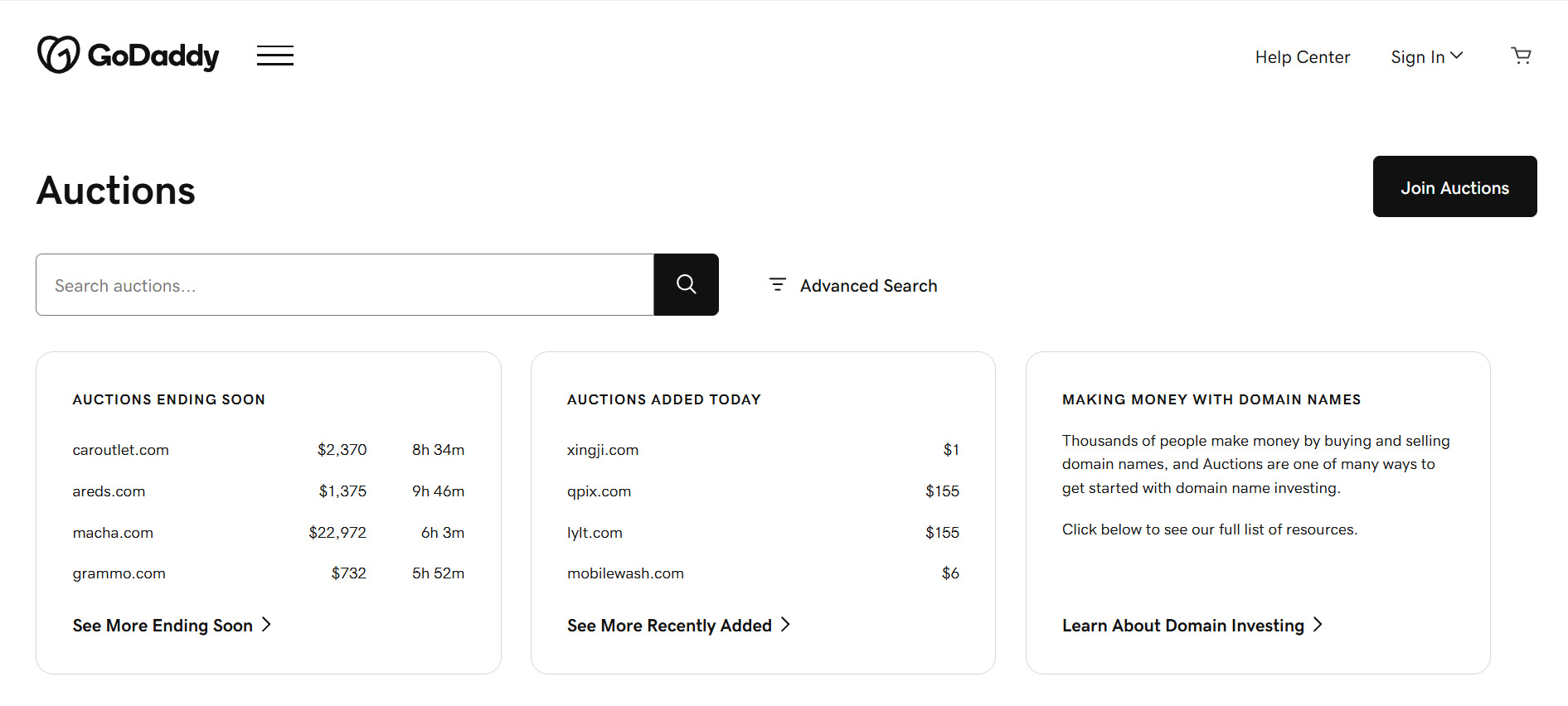
- NameJet – partner of major registrars, offers access to premium and expiring domains.
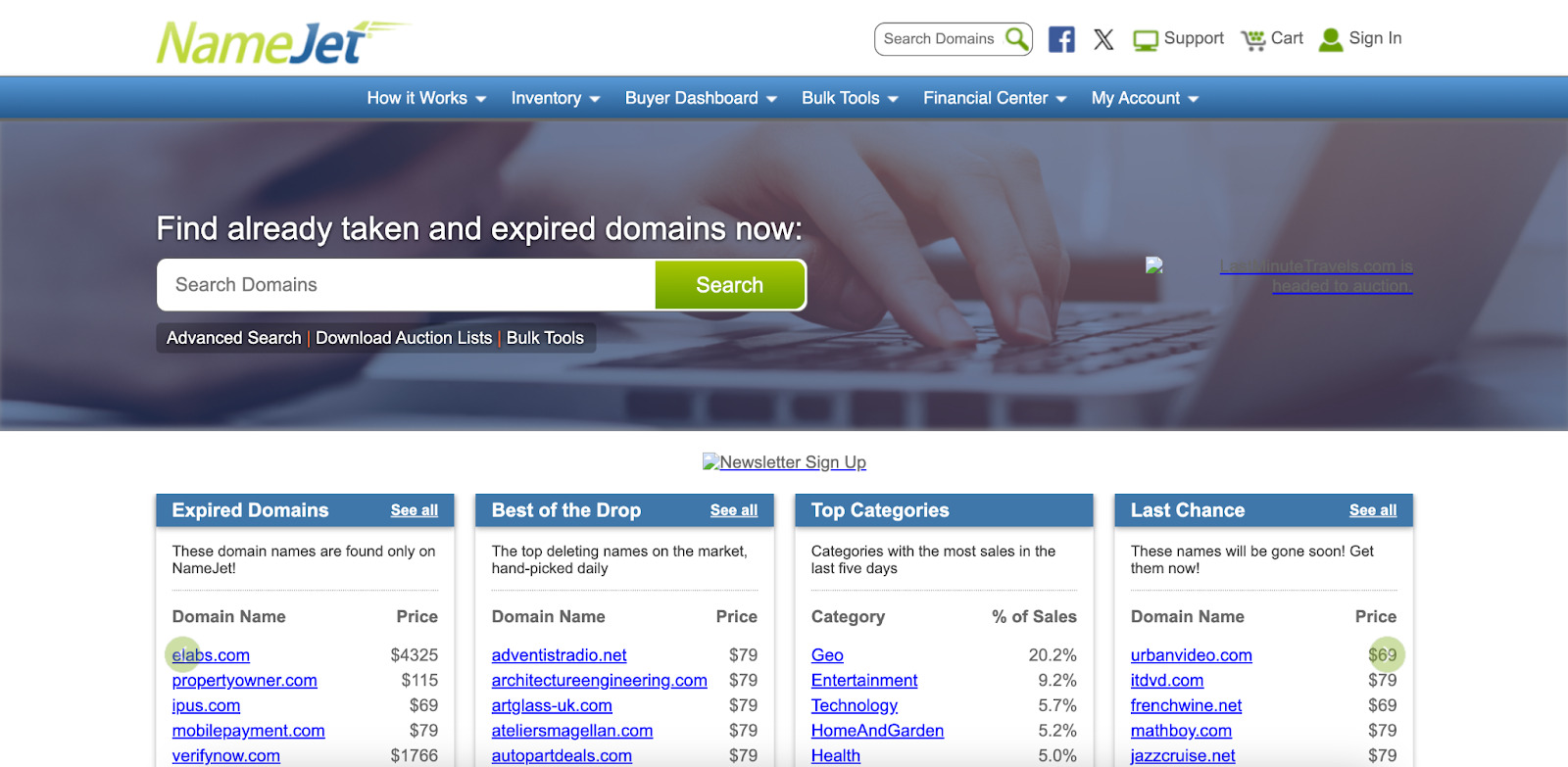
- SnapNames – another popular auction platform specializing in drop domains (domains whose registration has expired).
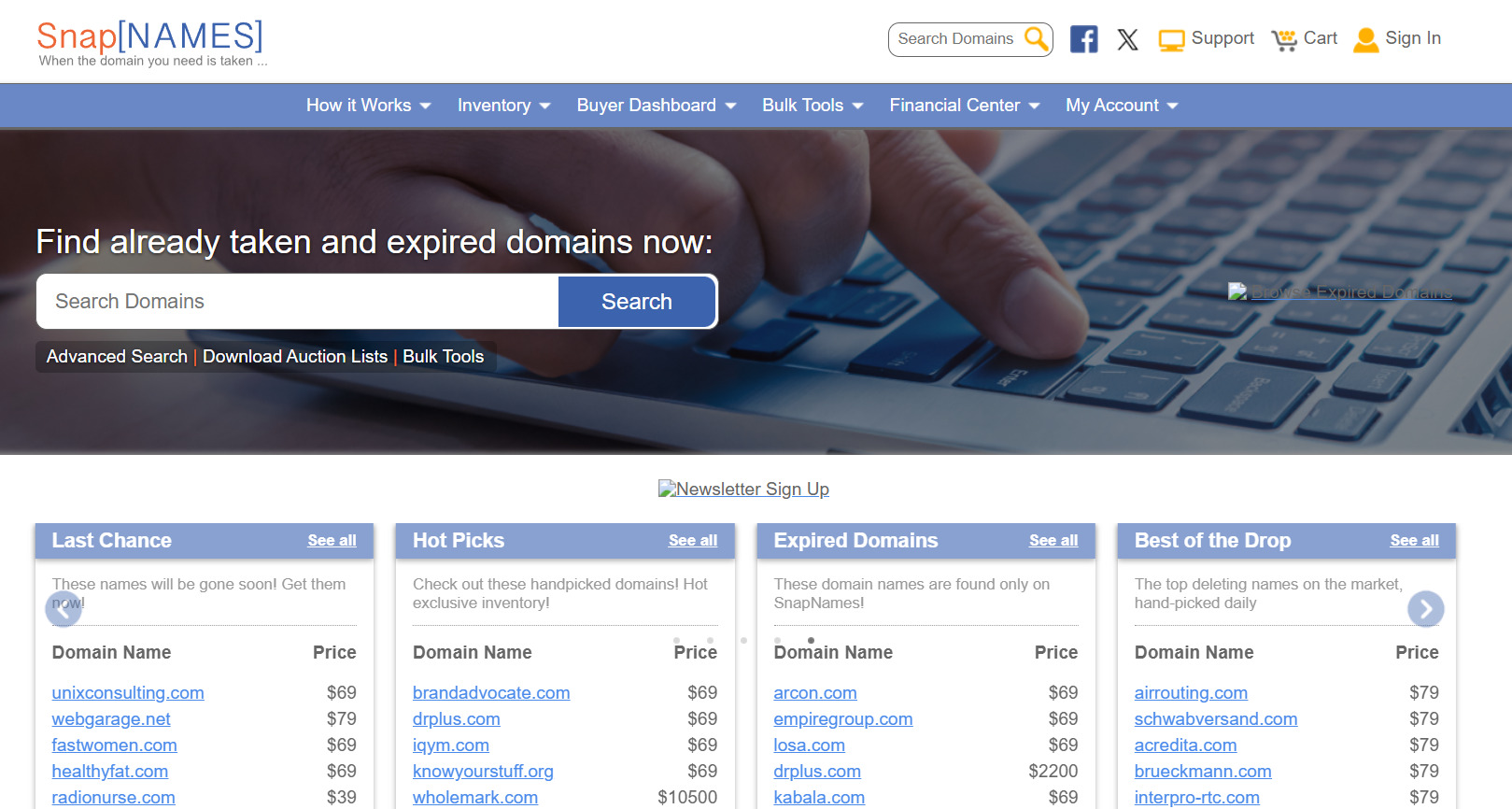
- Drop catalogs contain lists of domains that will soon be released or already released by previous owners. Popular services – ExpiredDomains.net and FreshDrop.com.
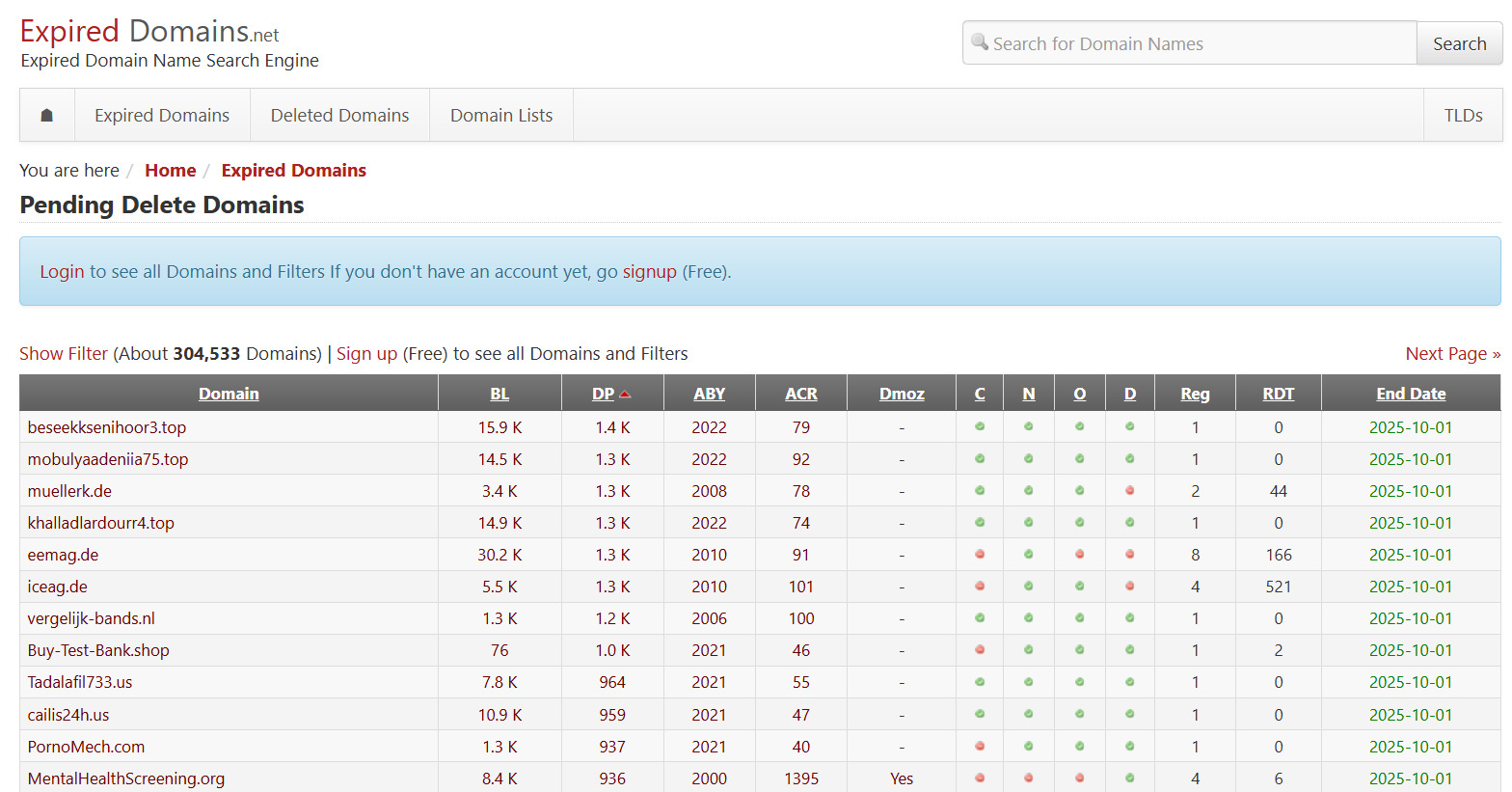
- Private sellers offer domains on forums and in specialized groups. Here you can find quality domains, but caution is needed when verifying them.
Criteria for Choosing Domains for PBN
Main criteria for a quality domain:
- Quality metrics:
- Domain Rating (DR) from Ahrefs – indicates the overall domain authority on a scale from 0 to 100.
- Trust Flow (TF) from Majestic – a trust indicator based on the quality of referring sites.
- Citation Flow (CF) from Majestic – total link mass quantity.
- Referring Domains – number of referring domains.
- Domain age. Aged domains enjoy search engine trust. However, the age needs to be confirmed by regular activity and the absence of prolonged periods of disuse. A domain with a uniform development history is always preferable to an old domain with gaps in activity.
- Thematic relevance. The domain should match the theme of the promoted project or related directions so that link weight transfer looks natural. For example, domains related to healthy nutrition, sports equipment, or workouts are suitable for promoting a fitness site. Thematic relevance increases the value of each link in the eyes of search algorithms.
- Link profile. Diverse donors with high Trust Flow indicators and natural anchor distribution characterize a quality profile. The presence of links from authoritative resources in the same thematic niche significantly increases domain value.
- Absence of penalties. Before purchase, check the domain for manual sanctions via Google Search Console and algorithmic filters via position tracking. Domains with a history in casino, betting, or adult content often remain under search engine scrutiny even after theme change.
Step 3: Deep Domain History Check
Never skip this step. Use WebArchive (Wayback Machine) to see what was on the site before. You need to ensure the domain:
- Was not used for prohibited content: casino, online betting, pharma, adult content, etc.
- Has no traces of previous PBN networks: identical designs on different domains, uniform articles with outbound links.
- Had a natural history: was a full-fledged project, not a facade for links.
A clean domain history is the guarantee that it's not banned and won't cause future problems. For in-depth analysis, you can also use services like SpamZilla, which aggregate data from various sources.
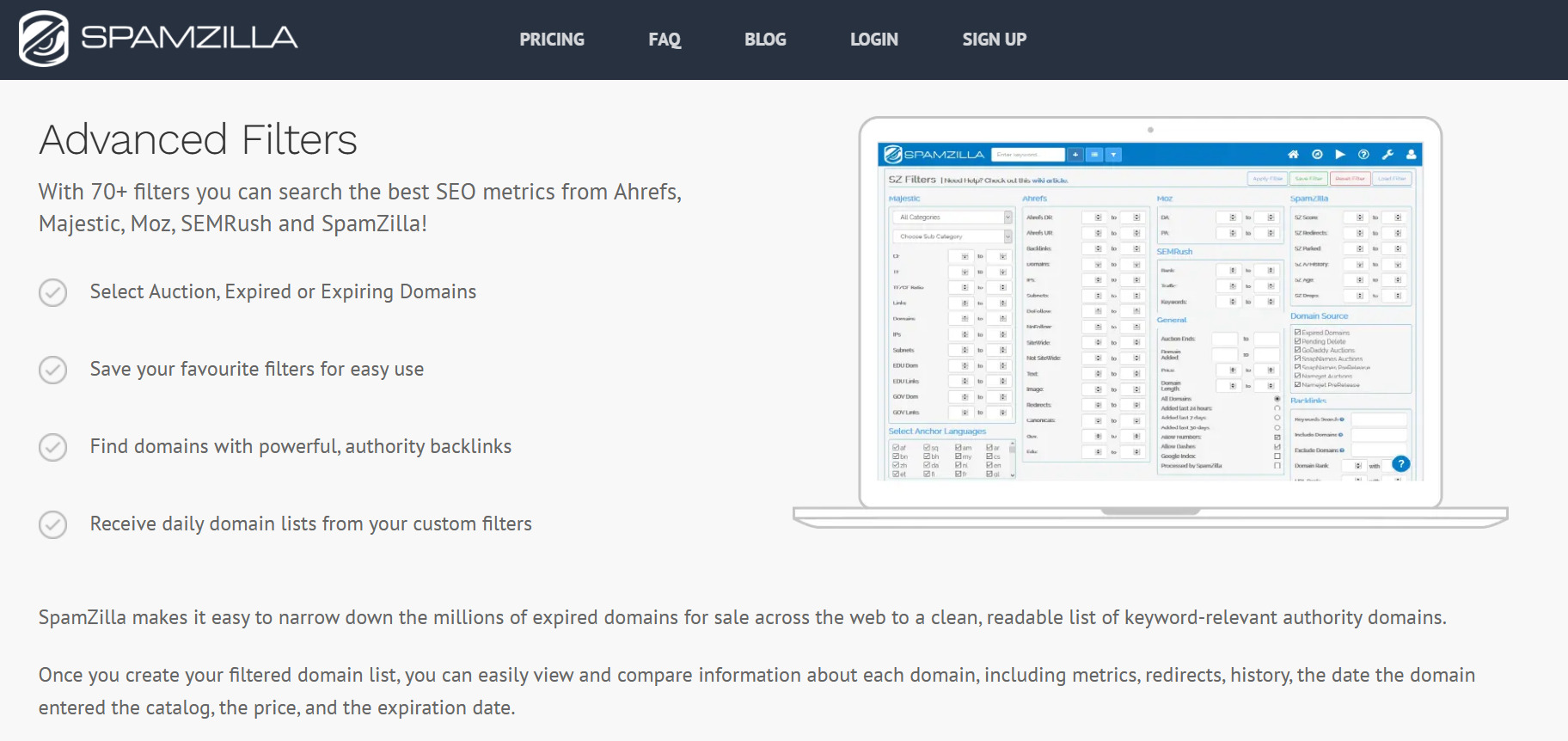
Step 4: Technical Setup and Diversification
To ensure security, all network sites must look like completely independent projects. They should have:
- Different hosting providers. Place sites with different hosting companies to avoid creating a common technical footprint. This prevents a situation where issues with one provider or analysis of its IP block lead to the discovery of your entire network.
- Unique IP addresses. Ensure sites are hosted on servers in different network segments (preferably in different C-class networks). Placing sites on adjacent or sequential IP addresses is a clear marker of an artificial network. Using unique IP addresses, geographically distributed across multiple providers, creates a natural picture of independent project placement.
- Different CMS and designs. Combine various content management systems like WordPress, Joomla, and Drupal to avoid uniformity in technical implementation. For each CMS, use visually distinct themes with unique page structures, as identical templates across sites can easily reveal their affiliation with one network.
- Whois protection. Activate privacy service for each domain to hide your personal data in the public Whois database. This is critically important for anonymity, as identical owner registration data is direct proof of connection between sites for search engines. This measure prevents easy and quick establishment of common ownership of all network domains.
Step 5: Creating Quality Content
Content is the foundation of naturalness for each PBN site. It must meet the following requirements:
- Uniqueness. All articles must be unique, without copy-paste.
- Usefulness and relevance. Content should match the site's theme and be interesting to users.
- Regularity. Publish new materials on a schedule, like in a real blog.
Depth and structure of content also play a critically important role. Articles should be full-fledged, revealing the topic, not short notes of 500 characters created just as a pretext to place a link.
Remember that the goal is to imitate a live, authoritative resource. This approach requires more resources, but it is the key factor in long-term security and PBN effectiveness.
Step 6: Choosing Types of PBN Backlinks and Their Placement
To make your link mass look natural, you need to combine different types of links, mimicking the organic growth of mentions about your project. In a real link profile, diversity is always present.
- Contextual links – this is your main tool. Place them in new and already published articles, organically integrating into expert content. Alternate their placement: one link can be in the first paragraph, another in the middle of the material, to avoid patterns. These are the links that search engines consider most valuable, as they look like natural recommendations.
- Sidebar or footer links are used for creating a background of permanent mentions, but you need to strictly limit their quantity. Place such a link on several network sites, but not all of them, and alternate it with other branded mentions or anchorless links.
- Homepage links have maximum weight, so apply them with special caution. Place such a link only on 1-2 of the most authoritative sites in your network and only for a specific period (e.g., 2-3 months), then replace it with a contextual link within the site. This allows getting a powerful boost for promotion without creating unnatural accumulation of the strongest links on all resources at once.
Step 7: Link Placement Schedule
Search engines easily recognize unnatural link placement patterns. Your strategy should precisely mimic natural link mass growth typical of a genuinely developing project. Avoid unnatural spikes.
For comparison:
- Natural growth – gradual and smooth addition of new sites to the network, along with links from them to your main project. Start with a minimal number of links (2-3 per site) and increase as new content is published. This approach requires patience, but it's the only safe option for long-term and stable results, as it doesn't provoke algorithms into suspicion.
- Burst – rapid placement of dozens of links in a short period. Such a method creates a sharp and easily detectable jump in your site's link profile. This activity almost guarantees algorithmic or manual sanctions, after which restoring positions will be extremely difficult.
Step 8: Tracking Indexing and Link Strength
Creating and placing a link is just the first stage of work. To make your efforts pay off, you need to ensure the link is not only indexed but also transfers weight and positively affects your ranking.
For effective tracking, use:
- Google Search Console (GSC). This is the main tool for monitoring PBN site indexing. Regularly check the "Pages" report for the status of indexed pages and the "Links" report for analyzing acquired backlinks. Pay special attention to notifications about manual sanctions and crawling errors, as these may indicate potential problems.
- Indexing check tools. Services like IndexCheck or bulk checks in Ahrefs/Semrush allow quick status tracking of dozens of URLs. Regular monitoring helps detect page drops from the index, which may indicate content quality issues or unnatural link patterns.
- Metrics monitoring. Systematically analyze the dynamics of authority (DR, TF) of PBN sites, as a drop in these indicators may signal link devaluation. Simultaneously, track the main site's positions on target queries to evaluate the real effectiveness of your link strategy and make adjustments in time.
Turnkey PBN Creation

Creating a PBN independently requires deep knowledge, significant time, and resources. An alternative is to order a turnkey PBN network from professionals.
Advantages of this approach:
- Time savings. You get a ready-to-work network without needing to delve into all technical details.
- Risk reduction. Experienced specialists know how to avoid common mistakes that can lead to sanctions.
- Access to quality domains. Professionals have access to premium and verified domains.
- Professional implementation: Proper technical setup, quality content, and thoughtful link placement strategy.
- Long-term support: Monitoring network performance and prompt problem resolution.
Order a Turnkey PBN Network from LinkBuilder.com
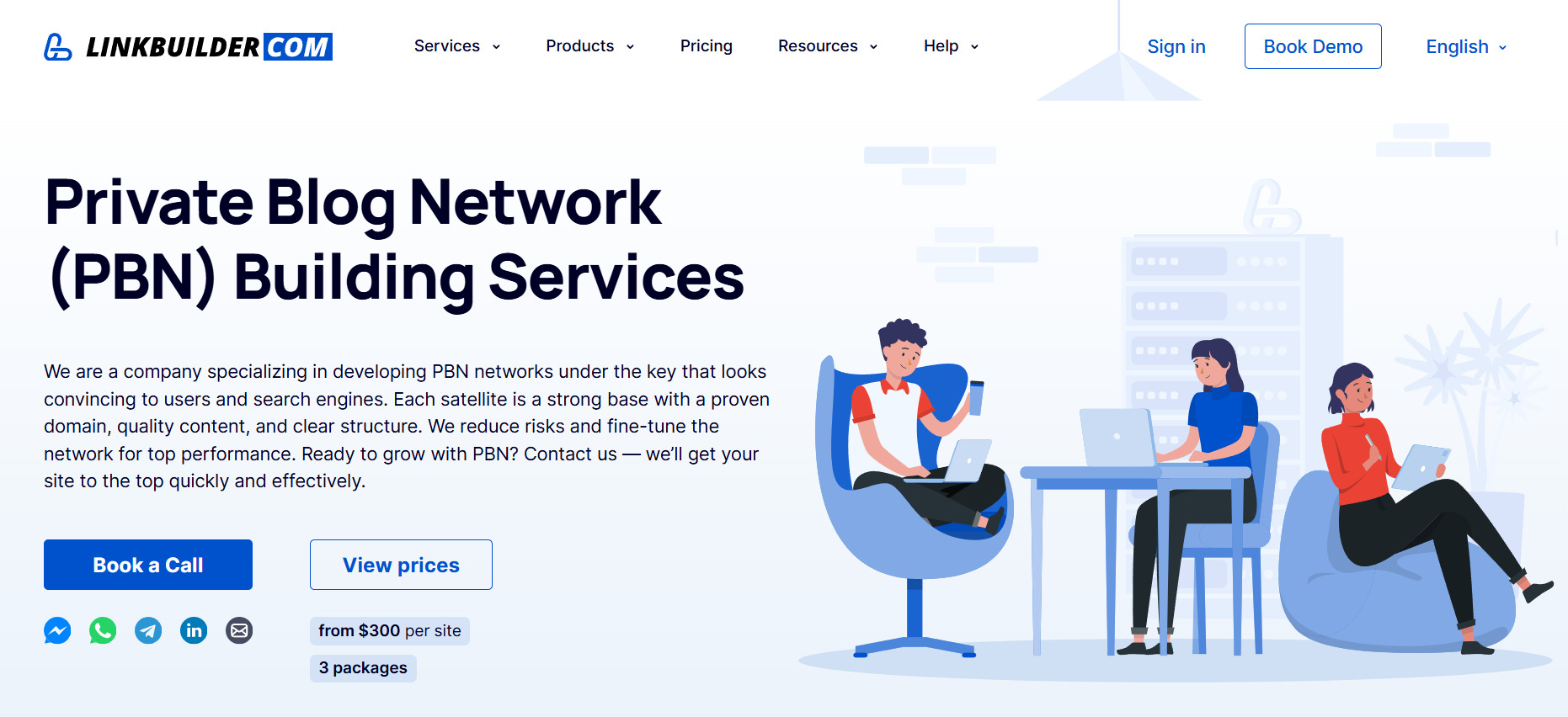
LinkBuilder.com is a professional service that offers a complete cycle of creating and maintaining private blog networks. We build PBN networks that deliver results.
The work process includes:
- Consultation and in-depth analysis of your goals and niche.
- Development of an individual promotion strategy.
- Expert selection of domains with impeccable history.
- Quality technical implementation with full diversification.
- Creation of unique, relevant content.
- Strategic link placement and ongoing monitoring.
This solution is suitable for business owners, SEO agencies, and specialists who value their time and want to minimize risks. Schedule a meeting to learn how a turnkey PBN can specifically benefit your business.
Safe Usage: How to Avoid Google Sanctions

Using a PBN involves risks, as search engines, particularly Google, actively combat unnatural links.
Main PBN risks:
- Algorithmic filters automatically detect unnatural links in search engines. Modern algorithms (e.g., Penguin) analyze various factors: technical site similarities, link placement patterns, content quality, and user behavior.
- Manual sanctions are applied by search engine specialists when violations are detected. Such sanctions can be harsher and more challenging to lift than algorithmic filters.
- Position loss occurs when search engines detect artificiality in the link scheme. Recovering positions after such a drop requires the complete removal of problematic links and can take several months. In particularly complex cases, the site may not return to its previous positions even after all violations have been fixed.
- Financial losses – investments in domain purchases, hosting, and content creation can be completely lost upon network detection. Additional expenses may arise from the urgent transfer of the project to new domains or the purchase of quality links from third-party resources. Saving on domain and content quality multiplies financial loss risks.
How to Use PBN Safely: Main Rules
We've already discussed the safe creation and use of PBN extensively in this article. Here we'll gather all points in one place so you can remember the basic PBN security rules:
- Maximum diversification: different hostings, IP addresses, CMS, designs, and domain registrars.
- Quality content: unique, valuable articles, excluding spun content and copy-paste.
- Natural anchor strategy: predominance of anchorless and diluted links (80-90%). Exact-match anchors – no more than 5-10%.
- Smooth link placement schedule: imitation of natural link mass growth, without sharp jumps.
- Relevance: PBN sites must be thematically related to your main resource.
To minimize risks, comply with all security principles when creating the network, use various promotional methods, and constantly monitor the network. Also, be prepared to remove problematic links at the first signs of issues.
Tools and Services for Monitoring PBN Links
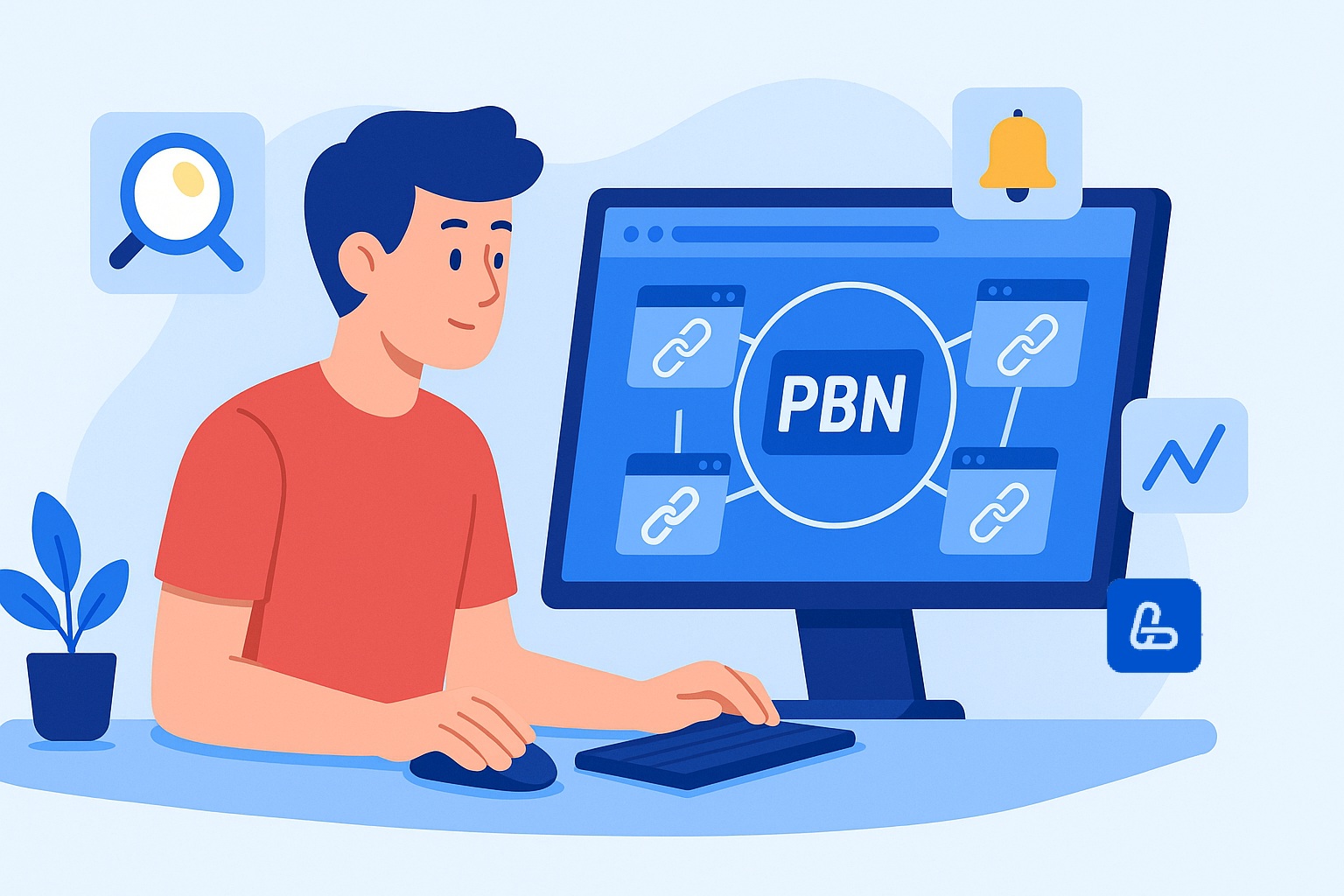
For successful PBN network control, specialized services are required. They help monitor site status, evaluate link effectiveness, and identify problems promptly.
- Position tracking tools (Serpstat, TopVisor) show how links affect ranking.
- Link analysis services (Ahrefs, Semrush) check indexing and detect lost links.
- Technical monitoring (UptimeRobot) controls site availability.
- Analytics systems (Google Analytics) track traffic and user behavior.
A comprehensive approach to monitoring enables a quick response to changes and keeps the network operational.
What to Do If Hit by Search Engine Penalties
First, determine the type and causes of the penalty through analysis of traffic and position changes. This affects the possibility of appealing it.
The action algorithm is as follows:
- Penalty diagnosis requires analyzing the timeframe of position drops in search engines, comparing with their algorithm updates, and studying messages in webmaster panels. It's essential to determine whether the penalty is automatic or manual.
- Removing problematic links – priority task upon detecting a penalty. Quickly remove links from problematic PBN sites or block them via the robots.txt file. Some cases may require a complete shutdown of network sites.
- Submitting a reconsideration request applies in case of manual sanctions. The request should contain a detailed description of measures taken to eliminate violations and proof of their implementation.
Position recovery can take a significant amount of time, especially in cases involving serious violations. It's important to remain patient and continue producing high-quality content and implementing natural site promotion strategies.
Key Takeaways
PBN remains a viable tool in SEO, but its use carries considerable risks. Success depends on three key factors: domain quality, proper technical implementation, and a carefully thought-out link placement strategy.
Developing a PBN requires deep knowledge and a significant time investment. If you want to save resources and reduce risks, it's better to order PBN network creation from LinkBuilder.com professionals. We will ensure quality work and long-term support for your network.
A properly created and skillfully managed PBN network can significantly enhance your site's visibility in search engines. Still, it requires constant monitoring and the ability to quickly adapt to algorithm changes.








